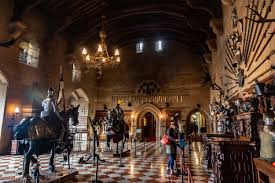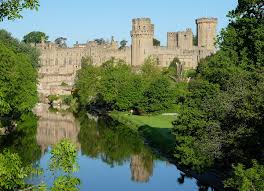Your basket is currently empty!
Introduction
Standing majestically on the banks of the River Avon, Warwick Castle is one of England’s most iconic medieval fortresses. Built shortly after the Norman Conquest in the 11th century, it has withstood rebellions, royal power struggles, and centuries of political change. Today, Warwick Castle remains a symbol of English medieval architecture and feudal power.
Built by the Normans – 1068
Warwick Castle was commissioned by William the Conqueror in 1068, just two years after his victory at the Battle of Hastings. Originally a wooden motte-and-bailey structure, it was later rebuilt in stone during the 12th century to fortify Norman rule over England. Its location was strategically chosen to control the Midlands and protect key trade routes.
A Stronghold of Power Through the Ages
Throughout its history, Warwick Castle was involved in major English conflicts, including the Wars of the Roses and the English Civil War. It was owned by powerful nobles, most famously Richard Neville, the “Kingmaker,” who played a decisive role in 15th-century royal politics. The castle’s towers, battlements, and gatehouse reflect its defensive and political significance.
Royal Connections and Noble Families
The castle was home to the Earls of Warwick, one of England’s most influential noble titles. Over the centuries, members of the Warwick family married into royal bloodlines, hosted monarchs like Queen Elizabeth I, and held substantial influence in the English court. Its legacy as a noble residence spanned nearly 900 years.
Architecture and Innovations
Warwick Castle evolved significantly from its original Norman design. The Caesar’s Tower and Guy’s Tower are classic examples of 14th-century military architecture. The castle also had moats, a barbican, and murder holes for defending against siege attacks. Later additions included luxurious interiors and gardens during the 17th and 18th centuries.
From Battlefield to Tourist Attraction

After centuries of warfare, Warwick Castle transitioned into a country home and later a heritage site. In the 20th century, it became one of England’s premier historic tourist attractions, offering reenactments, exhibitions, and medieval-themed events. Today, it’s part of the Merlin Entertainments Group and draws hundreds of thousands of visitors each year.
Legacy and Cultural Significance
Warwick Castle remains a powerful symbol of medieval England, capturing the imagination of historians, filmmakers, and travelers. It stands not only as a monument to military power but also to the artistry and complexity of feudal society. Its preservation is a testament to England’s dedication to historical heritage.
Conclusion
Whether you’re fascinated by medieval warfare, royal intrigue, or stunning architecture, Warwick Castle offers a journey through nearly a thousand years of English history. As one of the best-preserved castles from the 11th century, it continues to guard stories of conquest, rebellion, and nobility.
Want to dive deeper into Castles and Fortresses? Don’t miss our articles on Castles category.

